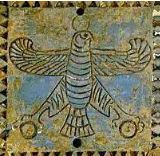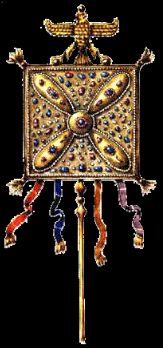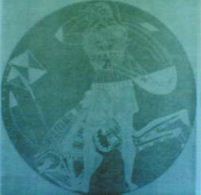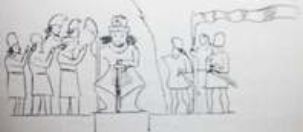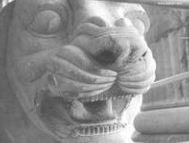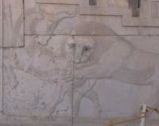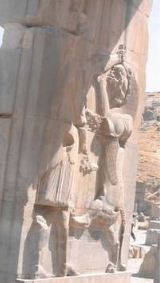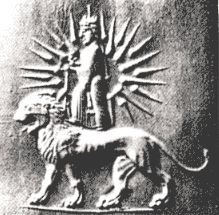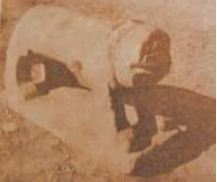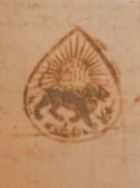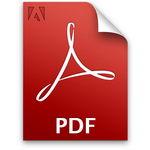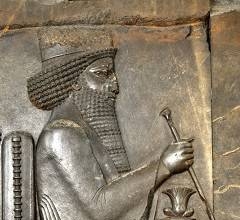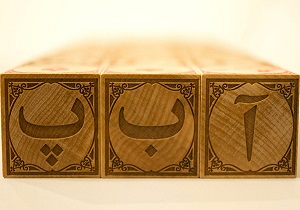Background of the thousand year old flag of Iran (2)
This article is a continuation of an article with the same topic on the site. To see the text of the history of the thousand-year-old flag of Iran (1) Here Click.
The flag during the time of the monarchy and empire Achaemenid
According to Herodotus and Xenophon, during the time of Cyrus the Great and Darius the Great, the Iranian army had raised insignia that was placed at the head of the corps. . Herodotus writes that when the great Xerxes thought of taking revenge on the Greeks and was on his way there, the sun caught fire on the way near the Hellespont, and Xerxes was enraged by this sign and called the priests and religious men and asked them to explain this. . Prophets and priests called the eclipse of the sun an untimely sign for the Greeks . So he went to Greece with a firmer determination
The door is magnificent Army Cyrus the Great
Xenophon mentioned in his book Anabasis that the emblem of the Iranian emperor is a golden eagle with open wings, which is placed on the tip of a spear.. According to historians, this shield is made of gold and is located on the head of a long spear that is used in Iran's battles with other countries and in Iran's national celebrations. .
* Zonaras, the famous historian of the twelfth century AD, mentioned the flag of Iran in the period before Cyrus the Great, the moon and the eagle, which was equal to the sun. . Later, during the Achaemenid Empire, the sun and the lion became symbols of the power, glory, and greatness of the Iranian nation. . “I was a course” He also considered the sun to be a symbol of the splendor and brightness of the Iranian monarchy . Lion is also one of our national symbols . According to the petroglyphs of Takht Jamshid, the lion is the symbol of Iran and the cow or other animals are the symbols of other countries . Some people also believe that the lion is a sign of the end of winter and the arrival of spring, which does not seem very logical. .
The magnificent cover of Darius the Great's imperial army
The sun is the embodiment of glory , Far Yazidi and Omar Javaid are in Iran . In seven parts of the Avesta, Ahuramazda is imagined as the sun, and in another place he is called the sun and the light of God's eyes. . Arda Virafnameh wrote in his book, then I traveled to another world and saw the heavens . Then I reached the place of good deeds and sunshine . I saw the pure soul of God there .
* In the last century, in the Casa del Fauno located in Pompeii, a mosaic was pulled out from under the soil, which shows a scene of the battle between the imperial army of Darius III and Alexander of Gogetsk. . In this ancient painting, the coat of arms of the Iranian army is painted in red or purple, with a golden eagle in the middle. . This outstanding work is in hand today and is kept in the museum .
* In the Louvre Museum in Paris, there is a cup made in ancient Greece . In this trophy, the fight of a Greek with a Persian soldier who raised the national flag of Iran is depicted . A Greek man has put a Persian soldier under his feet, but the Persian man has fallen under the feet of a Greek man, but the Iranian flag is still there. ( which is very similar to Kaviani's door ) He kept it high and did not let it fall . Because the opinion of Iranians is that under no circumstances should this national emblem be trampled and overthrown. .
The cup discovered from the battle between a Greek man and a Persian man and the Iranian Darfash
The flag during the time of the monarchy and empire tears
With great sadness, due to the fact that the Ashkani emperors had not widely publicized their history and actions, and the few documents left by them were destroyed by the Sassanid dynasty, our information about this is very little. . But what the historians have obtained from the ruins of their temples and palaces is that the clothes of the imperial army and the country of Iran were purple and probably decorated with gold and silver. . The Parthians undoubtedly had a very magnificent silk flag in the second century AD . Because the Romans have been envious of the glory of this flag many times in their books, there was a dragon on it. . This door was placed on top of a long spear, and some people believe that the eagle was a manifestation of the country's power and glory during the Ashkan dynasty. .
The flag during the time of the monarchy and empire Sassanid:
In the petroglyphs of Sassanid emperors , There are several national flags that have been raised during coronations and military parades. . In Bishabur, there is a petroglyph that belongs to Shahnshaha Shahpur II . Professor Hertzfeld deciphered it and identified the national flag of Iran at that time as a long flag with a long cloth. .
A painting of Sassanid inscriptions and Kaviani Darfesh in Bishapur
The famous Roman historian Amen Marcellin wrote about the flag of Iran during the time of Sassanid emperors : When the Iranians wanted to enter the battle with the enemies, they raised their fiery flag and in some cases the emperor himself entered the campaign at the head of the army. .
The flag of Emperor Bahram IV consisted of a long horizontal pole with two thick flares attached to it. . There was a small ring on top of it . In other words, it can be said that each of the emperors of Iran during the Sassanid period had their own door, but in the interior
All of them are similar to each other and in general they are similar to the Kaviani door .
National flag Kaoyanni
* Christensen has written about Iran's flag in the Sasanian History book : Each of the parts of the Sassanid imperial army is called Gand, the smaller divisions are called Darfash and the smaller ones are called Vasht. . every door ( Or part of the army ) The flag had properties that resembled a square that was placed on top of a long pole . Some of the emperors are sitting on a golden throne in the middle of the army, and some of them are riding horses at the head of the army. .
* In the valuable inscription, I found that the scene of the fall of the Roman emperor ( valerian ) In front of the Iranian emperor, it shows Shahpur I sitting on a horse with unparalleled power and glory, and the Roman Empire prostrated in front of him and asked for forgiveness. . On the back of this petroglyph and on the back of the Shahpur motif, a wavy fabric can be seen, which is the flag of Iran. .
Iran's flag after the Tazian attack
The lion is the national symbol and power of Iran
A stone lion statue discovered in Pasargad ( During the reign of Cyrus the Great )
The statue of the Iranian lion fighting with other tribes ( During the reign of Darius the Great )
The masonry of Persepolis, which shows the superiority of Iran over other countries
The lion and the sun are undoubtedly another of Iran's national emblems, which have a very ancient history . The oldest history of this national work is related to a cylinder related to King Suseter, King of Mitani, which is about 1450 He reigned in the year before Christ . In this cylinder, the shape of the sun with an open wing is visible, and there is a rod in the middle of it, and two taps are located on its sides. . Other works of Achaemenid and several petroglyphs from Shir show the power of Iran . Just as many countries consider animals as symbols for themselves, after Islam, Iran chose the lion and the ancient sun, which were respected and symbols of power in the past and ancient emperors, and today many Iranians consider it the only national symbol of Iran. they know .
The cylinder of the king of Mitani by year 1450 BC about the symbol of the lion and the sun
Valuable picture of ancient statue of Mitra and lion and sun – Leningrad Hermitage Museum – with the year 400 before birth
The figure of a lion with a sword in its waist belongs to a warrior named Shokrallah Kahrodi . A similar stone was discovered in Mahabad, Ardestan.
The first image on the Iranian flag
In the year 355 the sun 976 The year when the Ghaznavids took control of the affairs by defeating the Samanids, Sultan Mahmud of Ghaznavid for the first time ordered to embroider the image of a moon on his flag, which had a solid black background.. Then in the year 410 the sun (1031AD ) Sultan Masoud of Ghaznavi, motivated by his attachment to lion hunting, ordered the image of a lion to be replaced by the moon, and from then on
The image of a lion was never removed from the national flag of Iran until the Iranian revolution in 2011 1979 AD .
Added role The sun is on the lion's back
During the time of the Khwarezmshahs or the Seljuks, coins were minted with the image of the sun on the back, a formality that was quickly followed by flags as well.. There are two views about the reason for using the sun, one is that, like the lion, it is a symbol of courage and power, and it is a sign of the month of August. ( Assad ) and the sun is at its height and heat in the month of August, thus the correlation between the house of the lion ( Leo sign ) It is indicated by the middle of summer. Another theory indicates the influence of Mithraism and Mithraism in Iran and it is said that due to the sanctity of the sun in this religion, the ancient Iranians preferred the sun to be placed on the coins and the flag on the lion's back.
Flag in the Safavid era
Among the kings of the Safavid dynasty, ca 230 They ruled Iran for years, only Shah Ismail I and Shah Tahmasab I did not have lions and suns on their flags.. Shah Ismail's flag was solidly green and the image of the moon was on top of it. Shah Tahmasab was also born in the month of Farvardin ( Aries ) He ordered the image of a sheep instead of the lion and the sun ( Aries symbol ) draw on both flags and coins. The flag of Iran was green during the rest of the Safavid era, and the lion and the sun were painted on it.. Of course, the position and placement of the lion in all these flags was not the same, sometimes the lion was sitting, sometimes in profile, and sometimes facing the viewer.. In some cases, the sun is separated from the milk and sometimes it is attached to it. According to the travelogue of the French traveler Jean Chardin, his use of sharp and narrow flags with a verse from the Qur'an and the image of Ali's double-edged sword or the lion and the sun was a custom during the Safavid era.. It seems that until the time of the Qajars, the flag of Iran was three-cornered, not four-cornered, like the flag of Tazian
flag At Covenant Nader Shah Afshar
Nader, who was a self-made man, was able to free Iran from the rule of the Al-Tawaifi kings with a great effort, and once again unify and unite it.. His army advanced from the south to Delhi, from the north to Khwarezm, Samarkand and Bukhara, and from the west to Mosul, Kirkuk and Baghdad, and from the east to the Chinese border.. He shortened the aggression of Afghans from Iran . It was during this period that there were changes in the national and military flag of Iran. The royal flag or royal flag was made of red and yellow silk during Nader Shah's era, and there was a lion and the sun on it, but the national flag of Iranians at this time was three colors, green, white and red with a milk in profile and walking. It was going that a half-rising sun was on its back and inside the circle was written sun: ” God bless you ” Nader's soldiers, in the picture taken from his war with Muhammad Gorkani, the king of India, are holding a white triangular flag with a green stripe on the upper corner and a red stripe on the lower side.. A lion is walking in profile with its tail raised and inside the circle of the sun ” God bless you ” Come. Based on this, it can be said that the three-color flag of Ahed Nader is the mother of the current three-color flag of Iran. Because it was at this time that for the first time these three colors appeared on the military and national flags, although the flags were still three-cornered..
The shield obtained from the rare army of Shah Afshar
The course of The QajarsFour-cornered flag
During the Qajar period, which can be said to be one of the most shameful historical periods in Iran, Iran reached the border of collapse and disintegration, religious superstitions and thousands of other troubles, and during the period of Agha Mohammad Khan Qajar, the head of the Qajar dynasty, several fundamental changes in the form And the color of the flag was given, one is that its shape changed for the first time from three corners to a square, and the second is that Agha Mohammad Khan, because of his enmity with Nader, took the three colors of Nader's flag, green, white, and red, and left only the red color on the flag. put up a flag. There was a large white circle in the middle of this flag, in which there was the image of a lion and the sun as usual, with the obvious difference that for the first time a sword was placed in the lion's hand.
Was. During the reign of Feth Ali Shah Qajar, Iran had a dual flag. A single red flag with a lion sitting and the sun on the back, whose rays covered it all. The surprising thing is that the lion on the peacetime flag was holding a sword, while this was not the case on the wartime flag. At
It was the time of Feth Ali Shah that the use of the white flag for diplomatic and political purposes became customary. In the picture that a Russian painter of the arrival of the Iranian ambassador ” Abul Hasan Khan Shirazi ” A white flag with a lion, sun and sword drawn to the Russian Tsar's court is ahead of the ambassador.. Years later, Amir Kabir used this characteristic of the triple flags of the era of Feth Ali Shah and designed the current flag.. For the first time during the time of Mohammad Shah Qajar ( Successor of Fath Ali Shah ) A crown was placed on top of the sun. In this period, two flags or flags were used, on one of which was the two-headed sword of Imam Ali, and on the other was a lion and sun. The first flag was the royal flag and the second was the national flag.
And it was military in the year 1252 Hijri, during the time of Mohammad Shah Qajar, a decree was compiled that says the following about the flag of Iran : So they have arranged an address for each state . The government of Iran has been represented by the lion and the sun, and it is the same now . It has been the same sign for almost three thousand years, but more since the time of Zoroaster, because it is the sign of the sun and the amazing power of God, and the lion is both a sign of power and because most of the cities of Iran are located in the fourth Euclid and the movement of the sun is also in the fourth sign. They did not change the lion and the sun, and the same arrangement is still in place today “
Download the pdf file



